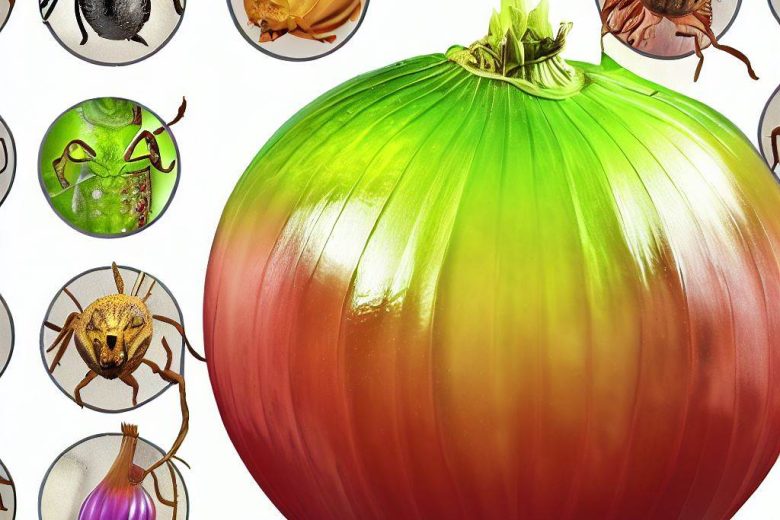Onions are a staple ingredient in countless culinary dishes worldwide, appreciated for their unique flavor and versatility. Whether used as a base for soups, salads, or garnishes, onions play a vital role in many cuisines.
However, like all crops, onions are susceptible to various diseases and pests that can significantly impact their growth and yield. In this article, we will explore ten common diseases and ten pests that affect onions and discuss methods to manage and prevent these issues.
10 Common Diseases and 10 Pests of Onions
1. Downy Mildew (Peronospora destructor):
Downy mildew is a fungal disease that causes yellowing and wilting of onion leaves, resulting in reduced bulb size. Proper spacing, good air circulation, and fungicide treatments can help manage this disease.
Read Also: 21 Fastest Growing Onions [Beginner’s Guide]
2. Botrytis Leaf Blight (Botrytis cinerea):
Botrytis leaf blight is characterized by grayish-brown lesions on onion leaves. It can be controlled by avoiding overhead irrigation and applying fungicides when necessary.
3. Purple Blotch (Alternaria porri):
Purple blotch manifests as purplish-brown lesions on onion leaves. Regular crop rotation and fungicide treatments can help prevent its spread.
Read Also: [Pdf Sample] Business Plan For Onion Farming Docx
4. Onion Smut (Urocystis cepulae):
Onion smut leads to the formation of black, powdery spore masses on onion plants. Infected plants should be removed and destroyed to prevent further spread.
5. White Rot (Sclerotium cepivorum):
White rot causes white, fluffy fungal growth on onion bulbs and roots. Crop rotation and planting resistant onion varieties are effective management strategies.
Read Also: [Beginners Guide] How To Grow Spring Onions in Singapore
6. Fusarium Basal Rot (Fusarium oxysporum f. sp. cepae):
Fusarium basal rot results in rotting at the base of onion bulbs. Crop rotation, soil sterilization, and selecting resistant onion varieties can help control this disease.
7. Neck Rot (Botrytis allii):
Neck rot causes rotting at the neck of onion bulbs during storage. Proper curing and storage conditions can prevent this issue.
8. Onion Downy Mildew (Peronospora destructor):
Onion downy mildew differs from regular downy mildew and affects the bulb rather than the leaves. Adequate spacing and proper sanitation practices can help manage it.
Read Also: [Beginners Guide] How To Grow Onions: Complete Handbook
9. Stemphylium Leaf Blight (Stemphylium vesicarium):
Stemphylium leaf blight results in elongated gray or brown lesions on onion leaves. Fungicides and good crop management practices can mitigate its impact.
10. Bacterial Rots (Pseudomonas spp.):
Bacterial rots cause slimy, foul-smelling onion bulbs. Prevention involves planting disease-free bulbs and practicing good sanitation in the field.
10 Common Pests of Onions:
1. Onion Thrips (Thrips tabaci):
These tiny insects feed on onion leaves, causing silver streaks and reducing plant vigor. Insecticidal soaps and natural predators like ladybugs can help control thrips.
2. Onion Maggots (Delia antiqua):
Onion maggots burrow into bulbs, resulting in rot and reduced yield. Row covers and crop rotation are effective methods to prevent infestations.
3. Cutworms (Agrotis spp.):
Cutworms cut down young onion plants at the base. Using physical barriers and introducing natural predators can deter these pests.
4. Wireworms (Various species):
Wireworms damage onion bulbs by tunneling through them. Crop rotation and using trap crops can help manage wireworm populations.
Read Also: 15 Best Fertilizers for Onions Farm [Organic & Inorganic]
5. Aphids (Various species):
Aphids suck sap from onion plants, leading to stunted growth and deformation. Insecticidal soap or neem oil can control aphid infestations.
6. Leaf Miners (Liriomyza spp.):
Leaf miners create winding tunnels in onion leaves, reducing photosynthesis. Removing affected leaves and releasing parasitic
Conclusion:
In conclusion, understanding and effectively managing the common diseases and pests that affect onions is crucial for ensuring a healthy and bountiful onion crop. By being aware of these threats and implementing preventive measures, onion growers can safeguard their harvests and contribute to the availability of this essential kitchen staple.
For those interested in diving deeper into onion diseases and treatment, there are numerous valuable resources available online and in agricultural publications. Exploring resources such as “Common Diseases of Onions and Their Control” and “Onion Diseases and Treatment” will provide growers with detailed insights into identifying, treating, and preventing onion diseases.
One particularly troublesome group of diseases to watch for is fungal infections. Onion fungus treatment involves employing fungicides, proper sanitation practices, and maintaining ideal growing conditions. By doing so, growers can minimize the impact of fungal diseases like Downy Mildew, Purple Blotch, and Botrytis Leaf Blight.
Additionally, bacterial diseases of onions can be addressed through proactive measures such as planting disease-free bulbs and practicing good field hygiene. Diseases caused by bacteria, such as Bacterial Rots, can be minimized by adhering to these guidelines.
We encourage our readers to share their experiences, observations, and insights related to onion diseases and pests in the comments section below. Your contributions can help create a valuable dialogue within the farming community and contribute to the collective knowledge needed to tackle these challenges effectively. Together, we can ensure a steady supply of delicious and nutritious onions for generations to come.



![How To Start Organic Farming In UAE [Beginner’s Guide]](https://agrolearner.com/wp-content/uploads/2023/12/Organic-Farming-780x520.jpg)
